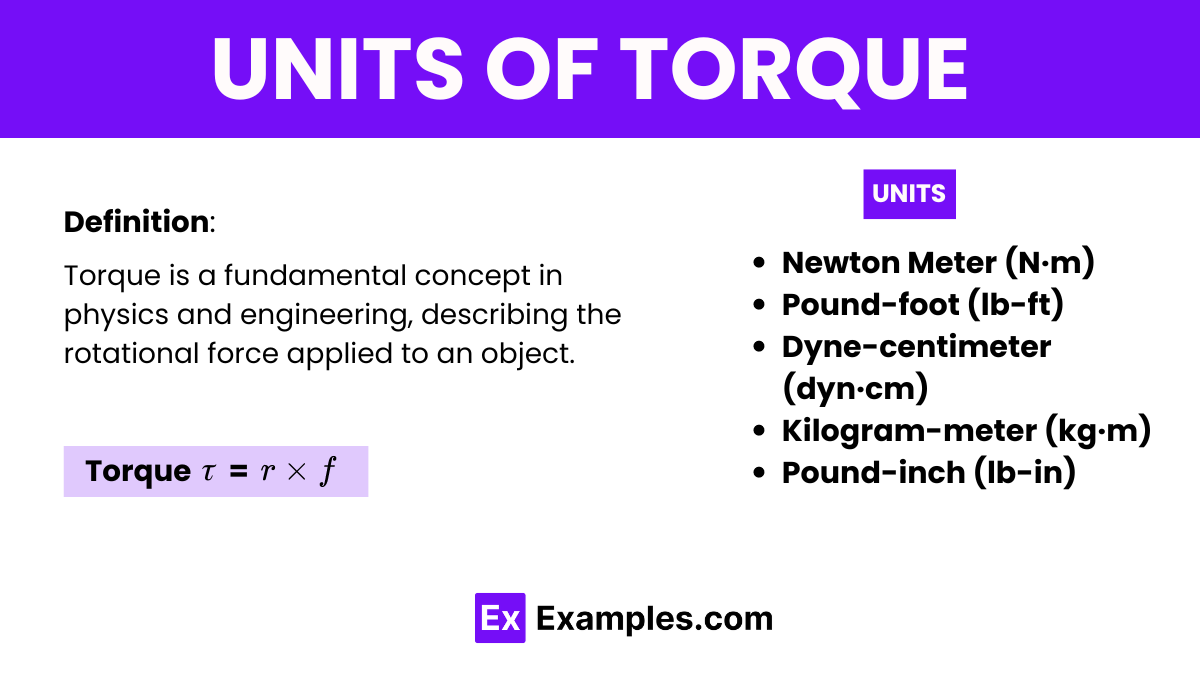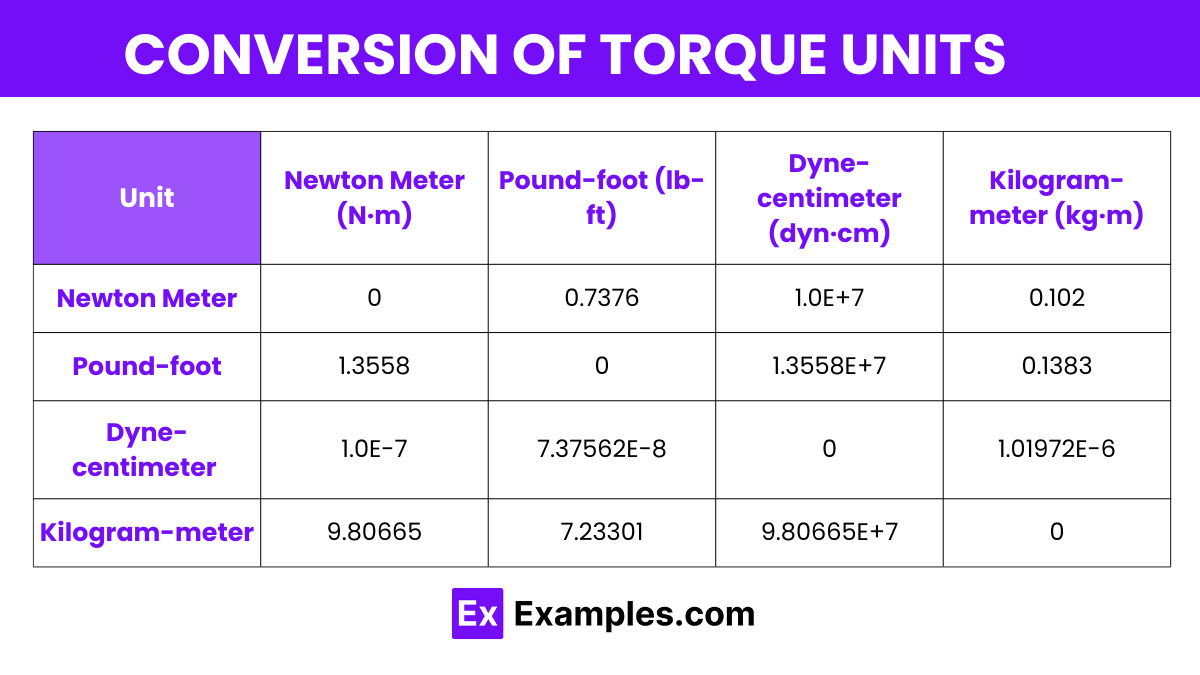What is the SI unit of torque?
Newton-second (N·s)
Newton-meter (N·m)
Joule (J)
Pascal (Pa)

Torque is a fundamental concept in physics and engineering, describing the rotational force applied to an object. It is a measure of how much a force acting on an object causes that object to rotate. The point where the force is applied is crucial in determining the amount of torque.
The newton meter (N·m) stands as the official SI unit for measuring torque. It quantifies the rotational force when a force of one newton is applied perpendicularly to a moment arm that extends one meter from the rotation axis.
In the Centimeter –Gram–Second(CGS) system, the unit of torque is known as the dyne-centimeter (dyn·cm). This unit measures the torque resulting from a force of one dyne applied perpendicularly to a lever arm one centimeter long.
The formula for torque (τ) can be expressed simply as:
| Unit | Symbol |
|---|---|
| Newton Meter | N·m |
| Pound-foot | lb-ft |
| Dyne-centimeter | dyn·cm |
| Kilogram-meter | kg·m |
| Pound-inch | lb-in |
The Newton Meter is the SI unit of torque, named for Sir Isaac Newton. It measures the torque resulting from a force of one newton applied perpendicularly to a point one meter from the pivot point. It is universally used in science and engineering to specify rotational force.
This unit is widely used in the United States, particularly in automotive and mechanical engineering. It represents the torque produced by one pound-force acting at a radius of one foot from the center of rotation.
A dyne-centimeter is the CGS unit of torque. It measures the torque resulting from a force of one dyne applied at a radius of one centimeter from the rotation axis, often used in physics to describe small-scale rotational forces.
This unit measures torque using the metric system, where one kilogram-force meter is the torque produced by one kilogram-force acting at a lever arm one meter long.
The pound-inch is another imperial unit of torque, commonly used in various applications requiring finer measurements than pound-feet, such as in small machinery or aviation.

Here’s a table format for different units of torque, showing conversion factors between common units like Newton Meters, Pound-feet, Dyne-centimeters, and Kilogram-meters:
| Torque Unit | Newton Meter (N·m) | Pound-foot (lb-ft) | Dyne-centimeter (dyn·cm) | Kilogram-meter (kg·m) |
|---|---|---|---|---|
| Newton Meter (N·m) | 0 | 0.7376 | 1.0E+7 | 0.102 |
| Pound-foot (lb-ft) | 1.3558 | 0 | 1.3558E+7 | 0.1383 |
| Dyne-centimeter (dyn·cm) | 1.0E-7 | 7.37562E-8 | 0 | 1.01972E-6 |
| Kilogram-meter (kg·m) | 9.80665 | 7.23301 | 9.80665E+7 | 0 |
Torque measures the rotational force applied around a pivot point, calculated as the product of force and the perpendicular distance from the pivot.
In US units, torque is commonly measured in pound-feet (lb-ft).
Horsepower does not equal torque; rather, horsepower quantifies the rate at which work is done, incorporating both torque and rotational speed in its calculation.
Text prompt
Add Tone
10 Examples of Public speaking
20 Examples of Gas lighting
What is the SI unit of torque?
Newton-second (N·s)
Newton-meter (N·m)
Joule (J)
Pascal (Pa)
If a force of 10 N is applied at a distance of 0.5 meters from the pivot, what is the torque?
2 N·m
5 N·m
10 N·m
20 N·m
Which of the following units is NOT used to measure torque?
N·m
ft·lb
J
kg·m
A torque wrench is set to 20 ft·lb. What is this torque in N·m? (1 ft·lb ≈ 1.356 N·m)
13.56 N·m
27.12 N·m
20.00 N·m
40.00 N·m
Which of the following expressions correctly defines torque?
Torque = Force / Distance
Torque = Force × Area
Torque = Force × Distance
Torque = Force / Area
A mechanic applies a 25 N force using a 0.4-meter-long wrench. What is the torque?
10 N·m
20 N·m
30 N·m
40 N·m
Which of the following combinations is a unit of torque in the Imperial system?
Newton-meter
Joule
Kilogram-meter
Pound-force foot
What happens to the torque if the force is doubled while the distance remains the same?
It is halved
It remains the same
It is doubled
It is quadrupled
A force of 50 N is applied at an angle of 90 degrees to a lever arm 0.3 meters long. What is the torque?
15 N·m
20 N·m
30 N·m
40 N·m
Which of the following pairs represents equivalent torque units?
Newton-second and Pound-force foot
Newton-meter and Joule
Newton-meter and Pound-force inch
Kilogram-meter and Pascal
Before you leave, take our quick quiz to enhance your learning!

